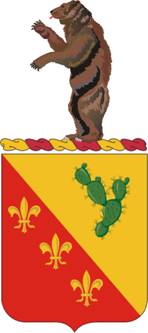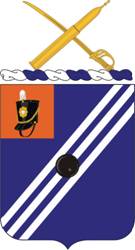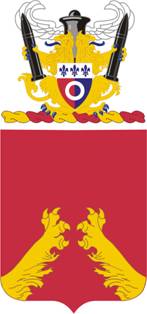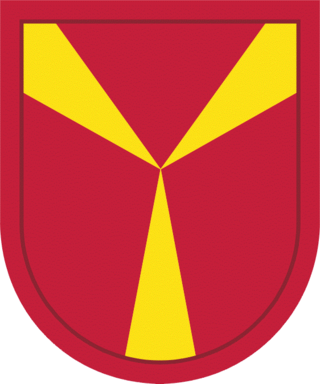The 200th Coast Artillery (AA) (200 CA) was a United States Army unit during the first half of World War II. Today descendant elements serve with the New Mexico Army National Guard as the 200th Infantry.

The 102nd Infantry Division ("Ozark") was a unit of the United States Army in World War II. The unit is currently active as the 102nd Training Division (Maneuver Support).

The 205th Infantry Brigade, was first formed as part of the United States Army Reserve's 103rd Division. It was active from 1921 to 1942 and then from 1963 through 1994, and then reformed in 2006.

The United States Army's 3rd Cavalry Division was created from the perceived need for additional cavalry units in the interwar period.

The 174th Infantry Brigade is an infantry brigade of the United States Army based at the Fort Dix entity of Joint Base McGuire-Dix-Lakehurst, New Jersey. A multi-component training unit, the brigade provides operational training and increased readiness for units in the continental Northeast.
The 5th Brigade, 78th Division was an AC/RC unit based at Joint Base McGuire–Dix–Lakehurst, New Jersey. The unit was responsible for training selected United States Army Reserve and National Guard units along the East coast. The brigade was a subordinate unit of First Army Division East, First United States Army when it was inactivated in 2006.

The 402nd Field Artillery Brigade has been absorbed into the 5th Armored Brigade. The 402nd was an AC/RC/NG unit based at Fort Bliss, Texas. The unit is responsible for training selected United States Army Reserve & Army National Guard units along the West coast. The unit was formerly designated as 3rd Brigade, 91st Infantry Division, and as the 402nd Brigade (Training). The Brigade is a subordinate unit of the First United States Army. From 1985 to 1996, the Brigade conducted artillery training at Fort Sill, Oklahoma.

The 157th Infantry Brigade is an active/reserve component (AC/RC) unit based at Camp Atterbury, Indiana. The unit is responsible for training selected United States Army Reserve and National Guard units. The unit was activated using the assets of the 5th Brigade, 87th Division. The brigade is a subordinate unit of First Army Division East.

The 75th Field Artillery Brigade is an artillery brigade in the United States Army. It is currently based in Fort Sill, Oklahoma and supports the III Armored Corps. The brigade is officially tasked to train and prepares for combat; on orders deploys to any area of operations to plan, synchronize and execute combined, and joint fires and effects. Integrate attached ground and air maneuver forces and on order function as a maneuver headquarters in support of full spectrum operations.

The 197th Infantry Brigade is an active Infantry brigade of the United States Army. The brigade was active as an Organized Reserve unit from 1921 to 1942, in the Regular Army from 1962 to 1991, and as a TRADOC training unit from 2007 to 2013. The brigade saw service in Operation Desert Storm with the 24th Infantry Division. On July 31, 2020, the brigade was activated as a training brigade in Fort Moore, Georgia, to serve the increased training needs of the army.

The 116th Cavalry Brigade Combat Team is the largest formation of the Idaho Army National Guard. It is headquartered at Gowen Field, Boise, Idaho. It has been reorganized into an Armored Brigade Combat Team (ABCT) but remains the only unit to be designated a "Cavalry Brigade Combat Team" by special appointment of the US Army. The 116th Cavalry Brigade Combat Team has units located throughout Idaho, Montana, Oregon, and Nevada. It was reorganized into a heavy armor brigade in 1989. Often referred to as the Snake River Brigade and formerly known as the 116th Armored Cavalry Regiment, the unit includes about 3,000 citizen-soldiers from Idaho.

The 129th Field Artillery Regiment is a regiment of the Field Artillery Branch of the United States Army, part of the Missouri Army National Guard. The 1st Battalion is the only active unit of the regiment, with the battalion Headquarters and Headquarters Battery in Maryville, Battery A in Albany, Battery B in Chillicothe, and Battery D in Independence. The battalion is a subordinate unit of the 130th Field Artillery Brigade, headquartered in Manhattan, Kansas.

The 76th Field Artillery Regiment is a field artillery regiment of the United States Army. First formed as a cavalry regiment in 1916, the regiment was converted to field artillery in 1917, and served in Europe during World War I with the 3rd Division and as a separate battalion during World War II, as well as in peacetime at Fort Knox, KY, and Fort Devens, MA. Since 1959, the regiment has been a parent regiment under the Combat Arms Regimental System and the U.S. Army Regimental System, with regimental elements serving with the 3rd Infantry Division in Germany and Operation Iraqi Freedom, with the 7th Infantry Division in Korea, and in the Army Reserve. No regimental elements are currently active.
The 377th Field Artillery Regiment is a field artillery regiment of the United States Army. A parent regiment under the U.S. Army Regimental System, the regiment's 2nd Battalion, 377th Field Artillery Regiment is assigned to the 2nd Infantry Brigade Combat Team (Airborne), 11th Airborne Division. Elements of the regiment have also served with the 101st Airborne Division and 82nd Airborne Division, and have seen service in World War II, Vietnam, and in both Iraq and Afghanistan during the Global War on Terror. The 1st and 3rd Battalions as well as Batteries D and E are Inactive.

The 428th Field Artillery Brigade is a training unit under the United States Field Artillery School, a formation under TRADOC. The brigade trains all officers and enlisted personnel from the U.S. Army and U.S. Marine Corps as well as allied nation military personnel in field artillery core competencies in order to provide proficient integrators of lethal and non-lethal fires to the operational force.

The 112th Field Artillery Regiment is a Field Artillery Branch regiment of the New Jersey Army National Guard first formed in April 1917. In December 1941, it was the last field artillery regiment in the U.S. Army to convert from horse-drawn to truck-drawn howitzers.

The 3rd Battalion, 321st Field Artillery Regiment is an artillery battalion, assigned to the 18th Field Artillery Brigade, part of the US Army XVIII Airborne Corps at Fort Bragg, NC. The battalion has served in World War I, World War II, and the Global War on Terror. The battalion is equipped with M142 HIMARS rocket launchers.

The 1st Battalion, 377th Field Artillery Regiment, is an inactive M198 Howitzer/ M777 Howitzer 155mm field artillery battalion of the United States Army. The battalion has seen service with the 101st Airborne Division during World War II and Vietnam, and deployed to Iraq and Afghanistan during the Global War on Terror. The battalion has been stationed with the 101st Airborne Division at Fort Campbell; with the 18th Field Artillery Brigade and the 82nd Airborne Division at Fort Bragg, North Carolina; and with the 17th Field Artillery Brigade at Fort Lewis, Washington.

The 101st Airborne Division Artillery (DIVARTY) is the force fires headquarters for the 101st Airborne Division at Fort Campbell, Kentucky. The DIVARTY has served with the division in World War II, Vietnam, Operations Desert Shield and Storm, Operation Iraqi Freedom, and in peacetime at Camp Breckinridge and Fort Campbell, Kentucky, and Fort Jackson, South Carolina. The DIVARTY was inactivated in 2005 as part of transformation to modular brigade combat teams, but was reactivated on 16 October 2014 to provide fire support coordination and mission command for the training and readiness of field artillery units across the division.
The 434th Field Artillery Brigade is a training/ artillery unit under the United States Army Fires Center of Excellence, a formation under TRADOC. The brigade conducts Basic Combat Training for new enlistees in the U.S. Army.
















